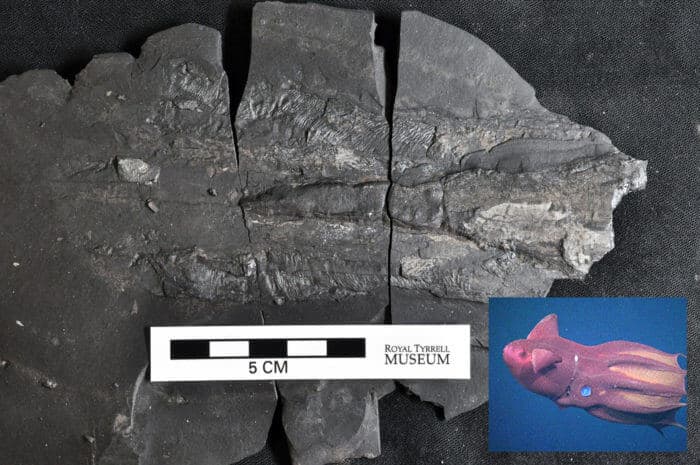Rowan Martindale, a professor at The University of Texas at Austin, with a slab of bivales recovered from a fossil site at Ya Ha Tinda Ranch. Rowan Martindale/The University of Texas at Austin Jackson School of Geosciences.
AUSTIN, Texas — A trove of exceptionally preserved Jurassic marine fossils discovered in Canada, rare for recording soft-bodied species that normally don’t fossilize, is expanding scientists’ view of the rich marine life of the period.
The preservation of the fossils—which include soft body parts as well as shells and bones—ranks the site among the highest quality sources of Jurassic (183 million year old) marine fossils in the world, and the only such site in North America. A paper describing the site and fossils recovered from it was published online in the journal Geology in January.
Rowan Martindale, a professor at The University of Texas at Austin, with a slab of bivales recovered from a fossil site at Ya Ha Tinda Ranch. Rowan Martindale/The University of Texas at Austin Jackson School of Geosciences.
AUSTIN, Texas — A trove of exceptionally preserved Jurassic marine fossils discovered in Canada, rare for recording soft-bodied species that normally don’t fossilize, is expanding scientists’ view of the rich marine life of the period.
The preservation of the fossils—which include soft body parts as well as shells and bones—ranks the site among the highest quality sources of Jurassic (183 million year old) marine fossils in the world, and the only such site in North America. A paper describing the site and fossils recovered from it was published online in the journal Geology in January.
A lobster, the first fossil found by the team at Ya Ha Tinda Ranch in Alberta, Canada. Rowan Martindale/The University of Texas at Austin Jackson School of Geosciences.
The new site was found on the Parks Canada Ya Ha Tinda Ranch near Banff National Park in southwest Alberta. Co-author Benjamin Gill, a professor at Virginia Tech, spotted the first exceptional fossil when he noticed his Ph.D. student and co-author, Theodore Them, standing right on top of a lobster.
“The lighting was just right to make out the outline of the lobster,” Gill said. “Then we looked around and noticed fossils all around us.”
The lobster was the first sign the site could be special because lobsters’ flexible exoskeletons usually aren’t preserved as fossils. Other unusual fossils recovered from the site include delicate shrimp, complete fish skeletons with scales and gills, large dolphin-like marine reptiles called ichthyosaurs, as well as “vampyropods” (related to modern vampire squid and octopus) with their delicate ink sacks still intact.
A newly discovered exceptional fossil site in North America gives a new look into marine communities from the Early Jurassic. All other known sites from that time period are in Europe. Rowan Martindale and Laura Martin/The University of Texas at Austin Jackson School of Geosciences.
The researchers have been visiting the site every summer since 2013 and have recovered dozens of fossils, including some that are probably newly discovered species. Notable specimens include a lobster with bulky arms capped with diminutive, scissor-like claws, and 16 new vampyropod specimens, a number that Gill estimates increases known diversity of specimens from North America by threefold.
“Every time we’ve gone, we’ve found something new,” Gill said. “It’s a really abundant place.”
The next step of the research is to investigate how so many diverse organisms were fossilized together. Researchers think that the high-quality preservation is related to a widespread extinction of marine life caused by a period of extremely low levels of oxygen in parts of the Jurassic oceans. Free of most scavengers, these low oxygen areas could have been an ideal place for a carcass to lay undisturbed and become beautifully fossilized.
“If a carcass sinks into anoxic water, you’re more likely to get the conditions that will favor the preservation of soft tissues, feathers and articulated skeletons,” Martindale said. “These ‘fossil jackpots’ are really special.”
The research was supported by the National Science Foundation and a research seed grant from the Jackson School of Geosciences.

